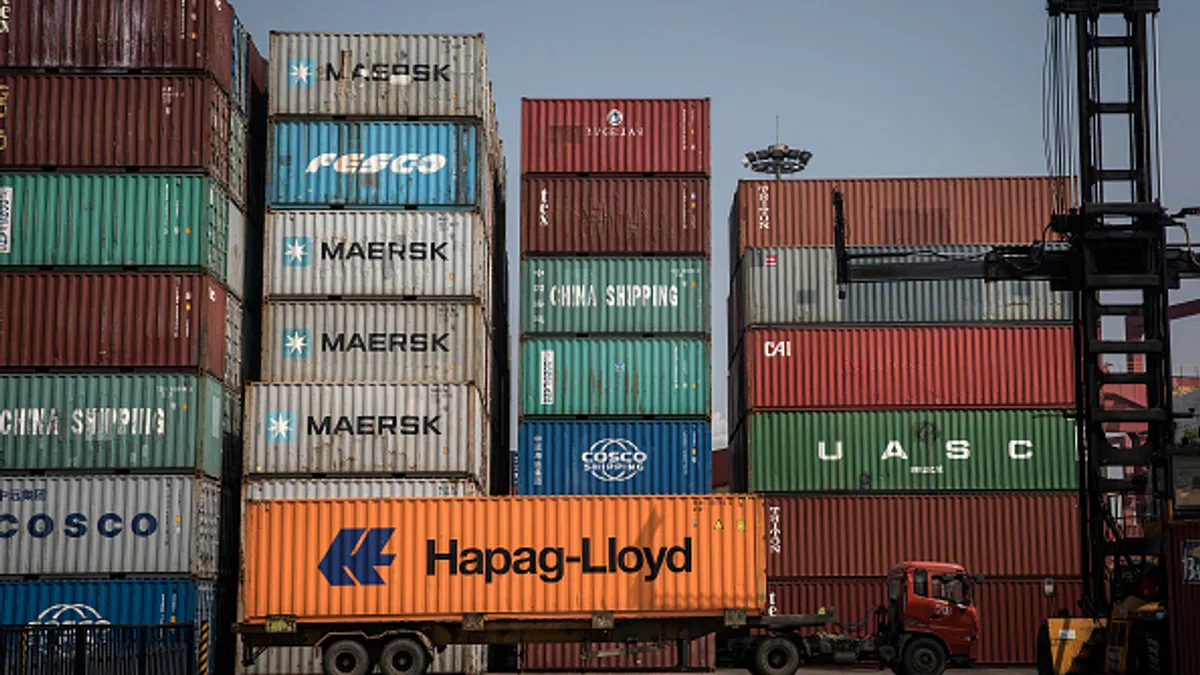Editor’s note: This article is the first installment of a three-part series exploring the push to rid the U.S. manufacturing industry of PFAS. Read the second installment on PFAS in firefighting foam and the third installment on auditing supply chains for forever chemicals.
Forever chemicals have been discovered in a growing number of places, including in food.
Whether it’s from fish caught in water contaminated by PFAS or dairy products from livestock exposed to the chemicals, humans can ingest the toxic substances from various sources.
Per- and polyfluoroalkyl substances can also be found in food contact substances and packaging, such as fast food containers and wrappers, grease-resistant paper, microwave popcorn bags and pizza boxes.
Environmental groups are growing increasingly concerned by the presence of PFAS in food. To combat these nerves, federal regulators such as the Food and Drug Administration have been reviewing and updating how to test for PFAS in food and evaluating which forever chemicals should be banned from the industry.
As the government aims to more closely regulate the intersection of PFAS and food, advocates are demanding a transparent testing process for chemicals already on the market, while some manufacturers have begun pitching alternatives to forever chemicals.
How the FDA decides which PFAS are allowed in food contact substances
The FDA's authorization of PFAS for use in contact with food generally falls into four application categories: nonstick coating applications; sealing gaskets for food processing equipment; manufacturing aids; and grease-proof agents for paper food packaging.
The federal agency has deemed the first three categories as having “negligible” migration capabilities to get into food and then people. The fourth — grease-proofing agents — was deemed unsafe and phased out of the market beginning in 2020 after the agency discovered that the substances could migrate into food.
In February, the FDA announced that all grease-proofing agents, substances applied to paper and paperboard packaging to prevent grease, oil or water from leaking, containing PFAS are no longer sold in the U.S. The announcement came four years after the agency secured commitments from food manufacturers to end the sale of products that contained the chemicals.
90% of PFAS chemicals detected in food contact materials are not screened by regulators, study shows
For nonstick cookware coatings and gaskets, PFAS molecules are polymerized — joined together to form large molecules — and applied to the cookware through a heating process that tightly binds the polymer coating to the cookware. The result, fluoropolymers, are PFAS plastics used in many well-known consumer products.

A changing PFAS landscape
The science behind PFAS is constantly evolving, including chemicals once deemed safe in foods.
For example, the harmful effects of long-chain PFAS, such as PFOAS, with eight-carbon length chains or longer, have been widely known to build up in the body. But for years, the FDA said that short-chain PFAS, with six carbons, weren’t harmful.
However, a 2020 study found that short-chain chemicals build up in lab animals just as much as long-chain PFAS do. This led to the FDA’s February 2024 phaseout of the short-chain PFAS grease-proofing agents.
A peer-reviewed study of data from the Food Packaging Forum published in the scientific journal Environmental Science & Technology in March found that 61 of 68 PFAS detected in food contact materials were “unintentionally” present, meaning they were not found in openly accessible and searchable regulatory lists or industry inventories. This disparity illustrates a gap between the types of PFAS used in the food industry and those screened for by government agencies and industry inventories.
Paper and board is most common food contact material detected to have PFAS, research shows
Maricel Maffini, an independent environmental health and chemical safety consultant, still wants to see the FDA do more research around short-chain PFAS and what exactly “negligible” amounts of migration into the body means.
“It is easier for the FDA to say the levels are negligible, but we don't have a real understanding of which ones are coming out and how much is negligible," Maffini said. "Which unit is the FDA using to determine that the level is negligible?”

Petitions for PFAS bans
Despite the phaseout, some environmental groups claim the FDA still isn’t doing enough to test and regulate the use of PFAS.
In July 2021, the Environmental Defense Fund and ten other NGOs filed a citizen petition asking the FDA to ban the use of all forms of PFAS that stay in the human body in regards to food contact materials. The FDA has yet to take any documented action on the petition.
Then in January of this year, the EDF and other groups submitted a food additive petition demanding the FDA remove its approval for fluorinating polyethylene — a chemical process that strengthens plastics. The FDA filed the petition on June 24 and has until Dec. 21 to make a decision regarding the request. However, the agency often misses this 180-day cutoff, according to Maffini, who wrote both petitions.
The FDA's regulation dates back to 1983 and allows the fluoridation of polyethylene using fluorine gas and nitrogen to have up to 5,000 parts per billion of fluorine in the container’s content.
“Why would you allow 5,000 parts per billion of fluorine, organic fluorine compounds in the food, when we know that most likely, there is no safe amount of PFAs?" Maffini said.

What environmentalists say manufacturers should be doing about PFAS
Agencies like the EPA and the European Medicines Agency, as well as food-related manufacturers, are starting to look at the presence of PFAS in supply chains.
Head of Corporate Sustainability at environmental non-profit Chemsec Jonatan Kleimark believes food manufacturers should do an impact assessment of PFAS in their supply chains.
After that, a company should evaluate existing alternatives.
"When it comes to alternatives, you need to more understand what is the property I need? Do I need this gasket to be highly UV stable or do I need it to be in order with food contact [material]? And therefore, you need to tailor which alternative works and does not work,” Kleimark said.
Manufacturers need to take into account if alternative additives will require different equipment in production, Kleimark added.
Yet, not all manufacturers are the same.
“The big problem is for small and medium-sized companies, which don't have large sustainability [teams] or they don't have the chemicals expertise," Kleimark said. "For them, it's very difficult. They will rely on their supply chain or the trade association to get the information on how to do this because they don't have the resources themselves."
Some manufacturers have been innovating in the kitchenware industry for years. Belgium-based The Cookware Co. introduced PFAS-free ceramic nonstick cookware in 2007. The company says it has created awareness about PFAS among its suppliers, buyers and consumers.
What changes do environmentalists want to see?
Environmental advocates are not only calling for better testing methods from the FDA, but more frequent and transparent evaluations.
“[Manufacturers] produce so many different byproducts when you make a polymer that [the FDA] doesn't have the standards to identify them, something that they also haven't asked companies to provide, so they wouldn't be able to test for something that they don't really know what it is,” Maffini said.
Currently, once the FDA deems a chemical is safe for certain uses under the Federal Food, Drug, and Cosmetic Act, it doesn’t test for chemicals again post-market.
But that could someday change. On Sept. 25, the FDA held its first public meeting on developing an enhanced systematic process for the agency's post-market assessment of chemicals in food, including PFAS.
This includes ingredients generally recognized as safe, such as food additives, color additives, food contact substances and contaminants. The new approach aims to help the FDA proactively identify and assess chemicals in the food supply based on risk under its new Human Foods Program.
Up for discussion was the FDA's potential integration of an advisory committee review into the postmarket assessment process, as well as the use of peer review to help inform the agency’s risk assessments.
Environmental groups spoke out at the meeting, calling for a ban on PFAS.
“The list of banned chemicals must include substances like phenyls or phthalates and PFAS, which are not going to be the normal food additives, but they become food additives by virtue of being food contact substances,” Policy Director at the Center for Food Safety Jaydee Hanson said at the meeting.
Maffini agreed that in regards to indirect food additives, the FDA should provide more information on the polymer byproducts and where they go, and even ask manufacturing companies to submit that type of information more frequently.
Yet, Maffini is encouraged by the FDA’s action to push for post-market chemical testing.
“Hopefully they will come up with a good plan, a good process. Transparency was the word of the day [at the meeting], and all stakeholders there agree that a reassessment system is needed,” she said. “So, hopefully we will see something next year, and we can react to that and submit more comments and help the agency to move forward.”
Visuals Editor Shaun Lucas and News Graphics Developer Jasmine Ye Han contributed to this story.













